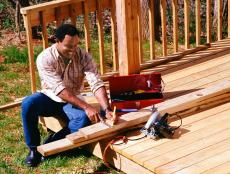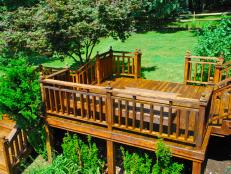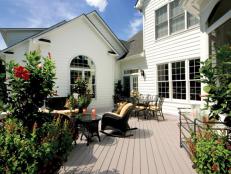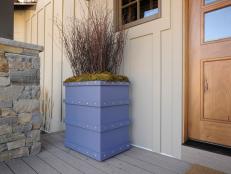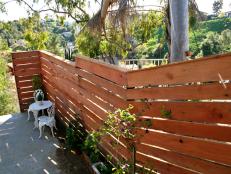A Hard-Working Deck Builder's Rig
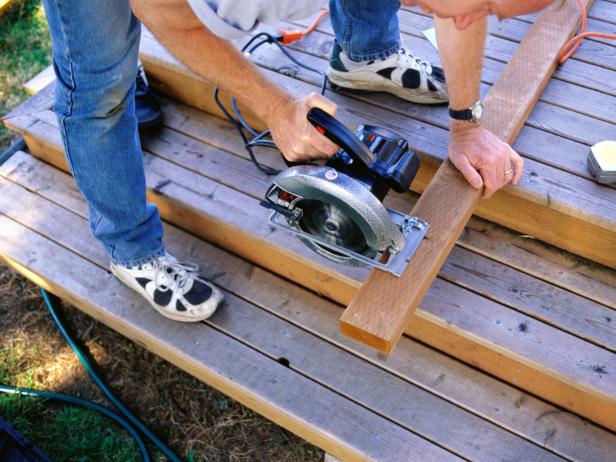
Ryan McVay
What I like about decks is that each one has a mix of site work, layout, framing and finish carpentry. You can build them with a basic set of hand and power tools, but you can build them better, faster and easier with the right tool mix. And the good news is that these deck builder's tools are terrific on other sites, so they pay for themselves quickly if decks aren't the only things you build.
Sitework
Hydraulic equipment. Of course, you can dig holes by hand, but, man, that's work. When you're staring down 35 three-foot deep postholes, it's nicer to look at them from the back of a compact skid-steer. An auger attachment drills straight, wide and clean post shafts up to four feet deep. The machine easily moves through gates and turns in tight spaces. Many can be configured with a bucket for earthwork and forks for moving or lifting materials.
While you might not be able to justify buying a skid-steer, renting one (and having it delivered and picked up) is an affordable option. Sunbelt Rentals rents the Toro Dingo, while The Home Depot rents a GK Prowler (no delivery). The Gravely Skidster is another popular model. Check United Rentals or your local yard for their version.
Hand tools. For small digs, you need four tools: a square-edged garden spade for cutting square shafts into the ground; a digging bar for tough soil and rocks; a long-handled shovel for removing the fill; and the will to dig deep.
Combination hammer. On digs with rock-hard clay, a mega-load of rocks or other obstructions, a 14-pound combination hammer like the Bosch 11241EVS equipped with a spade-iron and set on chip-mode breaks up tough clay and rocks without having to rent a jackhammer. It'll blast out concrete from existing footings (with bull-point or chisel) or other obstructions, and you can use it drilling for lag shields when fastening the ledger to concrete or masonry.
Layout
Laser levels. A laser level is the best way I know to strike a level line for a deck's ledger board. Shoot a dot at one side of the house in the deck location, mark it; shoot one at the other. Snap a line. Done deal.
Spirit levels. Two-, four- and six-foot spirit levels take you the rest of the way. Six-foot levels are great for framing, four-footers are nice for plumbing handrail posts, and a two-footer comes in handy in oddball locations like framing benches and double-checking stair stringers or grade-level decks.
Cutting
Circular saws. I use three circ saws on most deck sites. I can do it all with one, but not as fast. I have a Skil 8 1/4-inch worm drive for cutting 6x6. The amount of time and energy using an 8 1/4-inch saw saves here is hard to describe.
For lopping off joists, sizing decking, and general cutting, I use a 7 1/4-inch wormdrive. The front-heavy worm drive is also ideal for cutting joists to length once set in place. The tool gives you extra reach and its weight pulls it through the work.
On very wide decks I also run a Makita BSS610 6 1/4-inch 18 volt circ saw as my free-safety. It's great to move all over the place for sizing decking or squaring the ends of boards — and there's no cord.
Recip saw. You need a recip saw for finishing off the notches in 6 x 6 posts, but they're also nice for cutting back tree limbs, bushes and small stumps. Skil's toothy "ugly" blade is great for this.
Slider. A sliding compound miter saw is the perfect tool for setting up a production cut station when I have to install beveled 2 x 2 pressure treated pickets. I just set up a stop on my portable cut bench, then load the saw deck with pickets, bevel the saw and have at it. I also use the slider for cutting small handrail and framing blocks like for the Lowe's ChoiceDek handrail I recently installed. If you're installing a cedar or PT rail cap, the slider is ideal for getting the right miters.
Fastening
Cordless impact drivers. Not having one of these on a deck site just costs you time. Seriously. I like a 12, 14.4 or 18 volt unit for socking in lag or ledger screws, cinching carriage bolt assemblies and for screwing down decking. They're fast, tough and light — a great combination for deck builders. The new Lithium Ion impact drivers have awesome power and run time, too, which saves trips to the charger.
Auto-feed screw guns. If you're screwing down more than a coupe of decks per year, your knees, back and spirit will thank you for using an autofeed screw gun and collated fasteners.
Oddball
Protractor. I frequently site-build gates on my decks. Gate assembly is straightforward, but laying out the cross piece accurately was tricky until I discovered the Starrett ProSite Protractor. I use it to map out all kinds of funky angles and get precise cuts. In fact, I forgot my framing square on a recent deck project and used it to lay out a short run of stairs — it's a handy must-have.
Spiral saw. I use my Roto-Zip more and more to get me out of jams. With the right bit, they're at home in a deck builder's rig for cutting back aluminum and vinyl siding before flashing and installing the ledger board.
It's a great time saver — as are these tools. And if you build more than decks, you'll find yourself reaching into your deck builder's rig between deck projects. Just remember to put the tools back when you're done.
Mark Clement is a remodeler and author of The Carpenter's Notebook and Kid's Carpenter's Workbook: Fun Family Projects!








